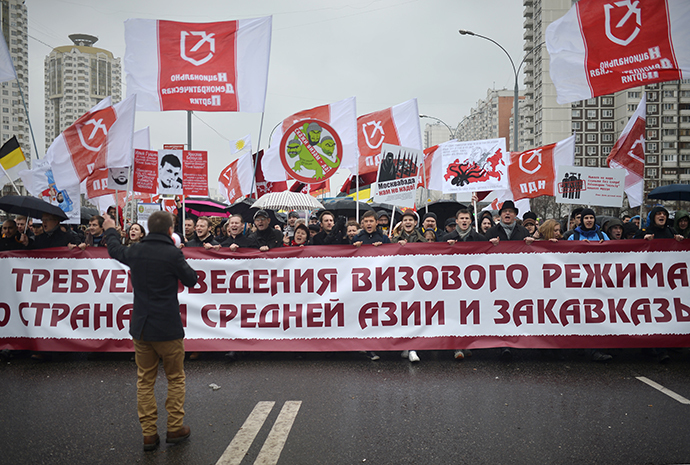
Nationalist demonstration in Moscow last month
The election in August 2013 of Sergei Sobyanin, an ultranationalist, as mayor of Moscow has given racism in Russia a prominent official face. Then last week, the mayor stunned the world by announcing that Moscow was banning the construction of new mosques. The ban was one of the latest and clearest signs of the growing anti-immigrant and anti-Muslim sentiments in Russia.
The four existing mosques in Moscow are overcrowded, but Mayor Sobyanin declared that no new mosques would be built because “they are used by migrant workers,” according to the Christian Science Monitor. A new mosque is currently under construction, but there won’t be any more, the mayor said. He told the Russian daily newspaper Komsomolskaya Pravda, “No new building permits will be issued. I think that’s enough mosques for Moscow.”
There are an estimated 2 million Muslim residents in the city, but none of Moscow’s four existing mosques can hold more than 10,000 people. Worshippers frequently have to use the streets or wait for hours to enter the existing mosques, especially on Fridays and religious occasions.
Russian Muslim activists say that Russian authorities have long tried to prevent construction of new mosques, but this is the first clear ban in recent memory.
Although most pronounced in Moscow, anti-Muslim and anti-immigrant racism is not confined to the capital city. According to the Moscow Bureau for Human Rights, surveys show that xenophobia and other racist expressions are prevalent among 50 percent of Russians. Amnesty International has reported that racism in Russia was “out of control” and estimated the number of Russian neo-Nazis in the tens of thousands.
Non-Muslims also face racist attacks. According to a study conducted by a prominent Church group, 59 percent of Africans living in Russia reported being physically attacked since coming to Russia, many of them multiple times. A staggering percentage of them (75 percent) reported being verbally abused. Those attacks took place despite the fact that a majority of Africans have reportedly started avoiding crowded areas, including the metro.
However, the most numerous and virulent attacks appear to be directed at Muslims, especially those from the Caucasus. They are Russian citizens by virtue of the Russian rule of their lands, but that fact has not shielded them from attacks nor provided them with adequate police protection outside their regions.
It was telling as Russia 1 television channel ran a program last October, when a prominent nationalist lawmaker called for imposing limits on the birth rate in the Muslim-dominated North Caucasus region of Russia, and restricting the movement of its people across the country. During the program, a live poll was conducted and he won the vote, with over 140,000 viewers voting for him.
Despite highly publicized hate crimes, authorities have not done enough to stem the tide of anti-Muslim attacks. In one of the most gruesome attacks in St. Petersburg, a group of skinheads stabbed a nine-year old Tajik girl, Khursheda Sultanova, to death. Another attack came to light when the Nazi Party of Russia publicized a video depicting the decapitation of a Tajik and a Dagestani youth.
Although these and other incidents have caused outrage outside Russia, attacks against Muslim Russians have continued unabated and have recently been on the rise.
According to the SOVA Center, which monitors xenophobia and violent crimes against ethnic minorities in the country, 10 people were murdered and 24 seriously injured in race-based hate crimes from May to July 2013 alone. From August to October, the number of victims of such crimes rose from 34 to 53. The center attributes that rise directly to the openly xenophobic, anti-migrant rhetoric of the Moscow mayoral race, which gave ultranationalists new political support.
According to the Levada Center, another rights monitoring group, over 30 percent of Russians and 49 percent of Muscovites have negative feelings toward the people of the Caucasus.
There has been vicious circle between the election of the new openly racist mayor of Moscow and the growing support for ultra-nationalists in the country. Muscovites seem to register nearly double the rate of anti-immigrant and anti-Muslim feelings compared to the rest of the country.
Vladimir Ryzhkov, a former Duma deputy and political talk show host, wrote in the Moscow Times recently, “Never before have the ruling elite so publicly and openly whipped up anti-migrant and xenophobic sentiments in society as they have over the past months.” He pointed to “a sharp surge in violent attacks over the past year based on xenophobic, racist and nationalistic motives. Radical youth patrol suburban commuter trains, pull non-Slavic-looking passengers from the wagons and beat them on the platforms with bystanders looking on.”
Despite the fact that Russia has been a multiethnic country for centuries, an increasing number of Russians today favor the mono-ethnic state suggested by the slogan “Russia is for Russians.” According to the Moscow Times, that idea finds support among 23 percent of the population and 43 percent of Muscovites, even though Moscow has always been a diverse, multiethnic city.
According to various polls, the mood against people from the Caucasus has grown extremely high, despite the fact that residents of the North Caucasus republic are fully-fledged Russian citizens. In fact, Caucasus natives appear to be the most-hated ethnic group, as we noted earlier. Those Russians who have targeted people from the Caucus do not seem affected by their legal status as citizens, or by the fact that Chechnya and other North Caucus have remained in the Russian Federation only because Moscow waged bloody wars to keep them under its rule. If given the chance, most of the Caucus people would probably be happy to leave Russia forever.
As Russia prepares to host the 2018 World Cup, the world spotlight will be trained on how it deals with rising racism. To improve its own image, if not for anything else, Russia needs to move fast to check this rapidly growing epidemic.
